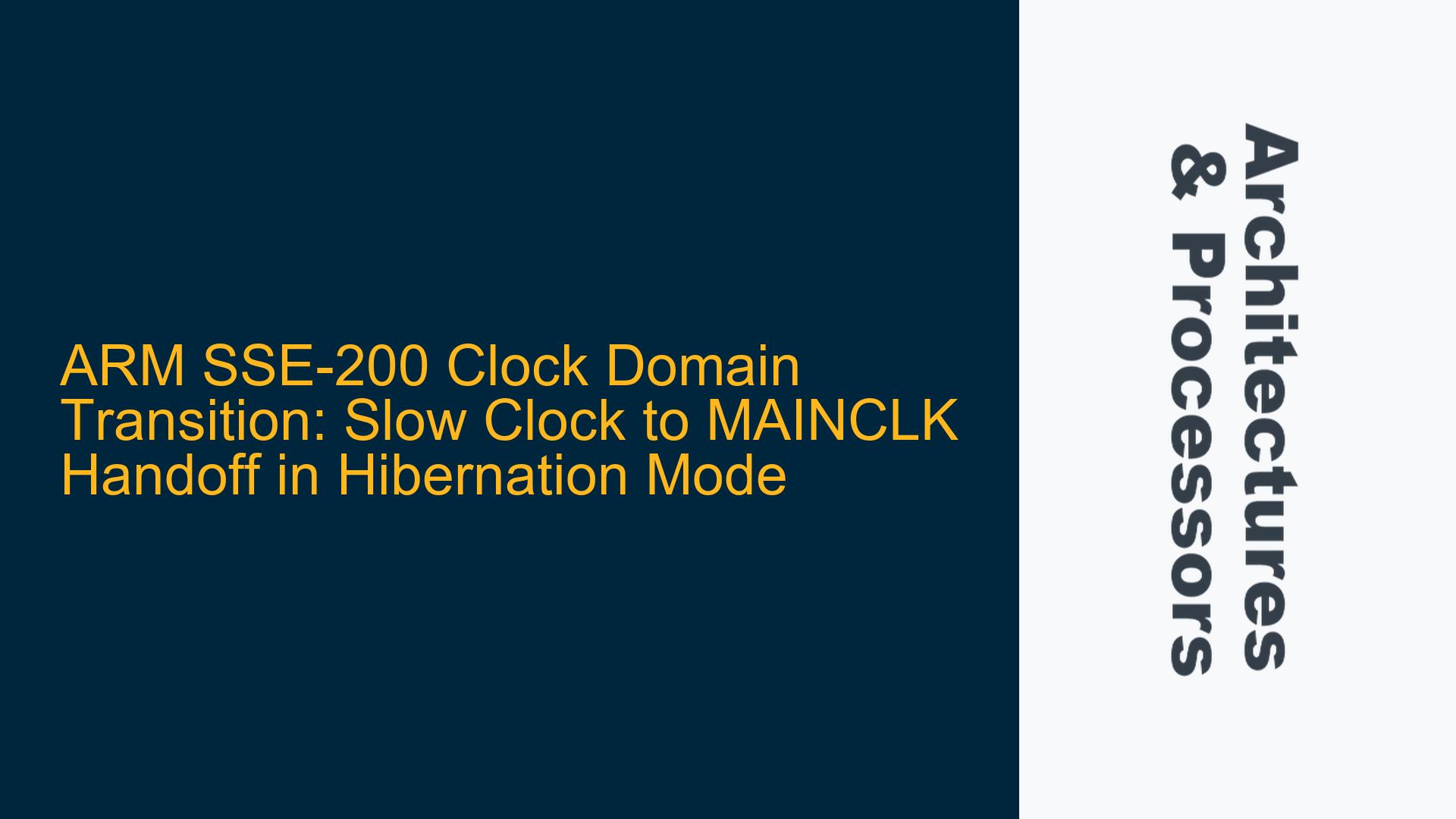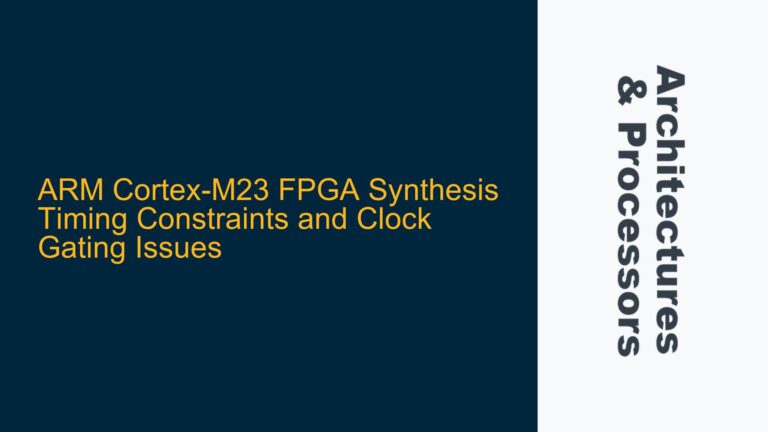ARM SSE-200 MAINCLKREQ and MAINCLKRDY Signal Timing in Hibernation Mode
The ARM SSE-200 subsystem employs a sophisticated clock management scheme to optimize power consumption, particularly during hibernation mode. In this mode, the MAINCLK is turned off to conserve power, and the system relies on a Slow Clock for minimal functionality. The transition between these clock domains is managed through two critical signals: MAINCLKREQ and MAINCLKRDY. MAINCLKREQ is a system request signal that initiates the activation of MAINCLK, while MAINCLKRDY is a status signal indicating that MAINCLK is stable and ready for use. The interaction between these signals and the Slow Clock during hibernation mode raises important questions about the timing and synchronization mechanisms involved.
The Slow Clock, typically running at a much lower frequency than MAINCLK, is responsible for maintaining basic system operations during hibernation. When the system exits hibernation mode, the Slow Clock must hand over control to MAINCLK, ensuring a seamless transition without disrupting system functionality. This handoff involves precise timing to avoid metastability and ensure that all subsystems are properly synchronized. The MAINCLKREQ signal is generated based on the Slow Clock, and the MAINCLKRDY signal is sampled to confirm that MAINCLK is ready. Understanding the relationship between these signals and the Slow Clock is crucial for designing robust power management strategies in ARM-based SoCs.
Potential Metastability Risks and Clock Domain Crossing Challenges
One of the primary concerns in the transition from Slow Clock to MAINCLK is the risk of metastability. Metastability occurs when a signal is sampled near the edge of a clock transition, leading to unpredictable behavior. In the context of the SSE-200 subsystem, the MAINCLKREQ signal is generated in the Slow Clock domain, while the MAINCLKRDY signal is sampled in the MAINCLK domain. This cross-domain interaction introduces potential timing violations that must be carefully managed.
The Slow Clock, due to its low frequency, has a significantly longer period compared to MAINCLK. When the MAINCLKREQ signal is asserted, it must be synchronized to the MAINCLK domain to ensure that the MAINCLKRDY signal is correctly interpreted. Failure to properly synchronize these signals can result in missed or delayed clock activation, leading to system instability. Additionally, the timing constraints for asserting and de-asserting MAINCLKREQ and MAINCLKRDY must be carefully analyzed to avoid overlapping or conflicting states.
Another challenge is ensuring that all subsystems dependent on MAINCLK are properly initialized before the clock is fully activated. This includes memory controllers, peripherals, and interconnect fabrics that may have specific timing requirements. The Slow Clock must provide sufficient time for these subsystems to stabilize before MAINCLK takes over. Any misalignment in this process can result in data corruption or system crashes.
Implementing Robust Clock Domain Synchronization and Verification Strategies
To address the challenges associated with the Slow Clock to MAINCLK transition, a multi-faceted approach is required. This approach involves careful design of synchronization circuits, rigorous timing analysis, and comprehensive verification strategies to ensure reliable operation.
Synchronization Circuits: The first step in mitigating metastability risks is the implementation of robust synchronization circuits. These circuits typically consist of a series of flip-flops that progressively stabilize the MAINCLKREQ signal as it transitions from the Slow Clock domain to the MAINCLK domain. The number of flip-flops required depends on the frequency ratio between the Slow Clock and MAINCLK, as well as the desired level of reliability. A common practice is to use a two-flip-flop synchronizer, but in cases where the frequency ratio is extreme, additional stages may be necessary.
Timing Analysis: Once the synchronization circuits are in place, a detailed timing analysis must be performed to ensure that all signals meet their setup and hold time requirements. This analysis should include both static timing analysis (STA) and dynamic timing simulations to cover all possible corner cases. Special attention should be paid to the timing of the MAINCLKREQ and MAINCLKRDY signals, as well as any other signals that cross between the Slow Clock and MAINCLK domains. The goal is to identify and resolve any potential timing violations before they can impact system performance.
Verification Strategies: Comprehensive verification is essential to validate the correctness of the clock domain transition logic. This verification should include both simulation-based and formal methods. Simulation-based verification involves creating testbenches that model the behavior of the Slow Clock and MAINCLK domains, including edge cases such as rapid transitions between hibernation and active modes. Formal verification, on the other hand, uses mathematical techniques to prove that the design meets its specifications under all possible conditions. Combining these methods provides a high level of confidence in the design’s robustness.
Power Management Considerations: In addition to synchronization and timing, power management must be carefully considered during the design process. The transition from Slow Clock to MAINCLK should be optimized to minimize power consumption while ensuring reliable operation. This may involve dynamically adjusting the clock frequencies or using clock gating techniques to disable unused portions of the system during the transition. Power-aware verification tools can be used to analyze the impact of these techniques on overall system performance and power consumption.
Debugging and Diagnostics: Finally, it is important to include debugging and diagnostic features in the design to facilitate troubleshooting in the event of a failure. This may involve adding status registers that provide visibility into the state of the MAINCLKREQ and MAINCLKRDY signals, as well as any synchronization circuits. These registers can be accessed during system operation to monitor the clock transition process and identify any issues that may arise.
By following these steps, designers can ensure a reliable and efficient transition between the Slow Clock and MAINCLK domains in the ARM SSE-200 subsystem. This not only improves system performance but also enhances power efficiency, making it an essential consideration for modern ARM-based SoCs.






